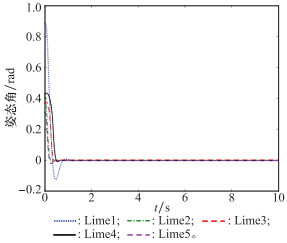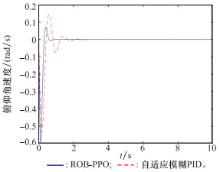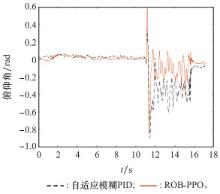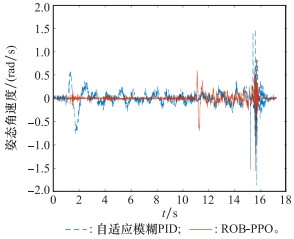Systems Engineering and Electronics ›› 2024, Vol. 46 ›› Issue (3): 1038-1047.doi: 10.12305/j.issn.1001-506X.2024.03.30
• Guidance, Navigation and Control • Previous Articles Next Articles
Robust observer-based deep reinforcement learning for attitude stabilization of vertical takeoff and landing vehicle
Yanling LI1, Feizhou LUO2, Zhilei GE1,*
- 1. School of Astronautics, Northwestern Polytechnical University, Xi'an 710072, China
2. China Academy of Launch Vehicle Technology, Beijing 100076, China
-
Received:2023-02-17Online:2024-02-29Published:2024-03-08 -
Contact:Zhilei GE
CLC Number:
Cite this article
Yanling LI, Feizhou LUO, Zhilei GE. Robust observer-based deep reinforcement learning for attitude stabilization of vertical takeoff and landing vehicle[J]. Systems Engineering and Electronics, 2024, 46(3): 1038-1047.
share this article
| 1 |
ZHOU Y M , ZHAO H R , LIU Y L . An evaluative review of the VTOL technologies for unmanned and manned aerial vehicles[J]. Computer Communications, 2020, 149, 356- 369.
doi: 10.1016/j.comcom.2019.10.016 |
| 2 | LIU H , LIU Y , WANG Y , et al. Recovery control strategy of reusable launch vehicle based on dynamic model[J]. Journal of Aerospace Engineering, 2019, 32 (5): 04019035. |
| 3 | HUDSON G C. History of the phoenix VTOL SSTO and recent developments in single-stage launch systems[C]//Proc. of the 4th International Space Conference of Pacific-basin Societies, 1991: 329-351. |
| 4 | COX K L. Design development of the Apollo lunar module[C]//Proc. of the NASA Washington 4th Inter-Center Control Systems Conference, 1978. |
| 5 |
FREEMAN D C , TALAY T A , AUSTIN R E . Reusable launch vehicle technology program[J]. Acta Astronautica, 1997, 41 (11): 777- 790.
doi: 10.1016/S0094-5765(97)00197-5 |
| 6 | NARUO Y, TOKUDOME S I, ISHⅡ M, et al. Design and operational aspect of LOX/LH2 propulsion system of reusable vehicle testing (RVT)[C]//Proc. of the AIAA/NAL-NASDA-ISAS 10th International Space Planes and Hypersonic Systems and Technologies Conference, 2001: 20-23. |
| 7 | DREYER L. Latest developments on SpaceX's Falcon 1 and Falcon 9 launch vehicles and Dragon spacecraft[C]//Proc. of the IEEE Aerospace Conference, 2009. |
| 8 | SAGLIANO M, TSUKAMOTO T, HEIDEIDECKER A, et al. Robust control for reusable rockets via structured H∞ synthesis[C]//Proc. of the 11th International ESA Conference on GNC Systems, 2021. |
| 9 |
SIMLICIO P , MARCOS A , BENNANI S . Reusable launchers: development of a coupled flight mechanics, guidance and control benchmark[J]. Journal of Spacecraft and Rockets, 2020, 57 (1): 74- 89.
doi: 10.2514/1.A34429 |
| 10 | WU X , XIAO B , QU Y . Modeling and sliding mode-based attitude tracking control of a quadrotor UAV with time-varying mass[J]. ISA Transactions, 2019, 126, 436- 443. |
| 11 |
ALTAN A , HACIOGLU R . Model predictive control of three-axis gimbal system mounted on UAV for real-time target tracking under external disturbances[J]. Mechanical Systems and Signal Processing, 2020, 138, 106548.
doi: 10.1016/j.ymssp.2019.106548 |
| 12 | LIU D Y , LIU H , ZHANG J S , et al. Adaptive attitude controller design for tail-sitter unmanned aerial vehicles[J]. Journal of Vibration and Control, 2021, 27 (1/2): 185- 196. |
| 13 | KUANTAMA E , VESSELENYI T , DZITAC S , et al. PID and fuzzy-PID control model for quadcopter attitude with disturbance parameter[J]. International Journal of Computers Communications & Control, 2017, 12 (4): 519- 532. |
| 14 | WANG L , ZHANG J . Adaptive fuzzy PID control of a vertical takeoff and landing aircraft[J]. ISA Transactions, 2021, 117, 308- 318. |
| 15 | SANTOSO F , GARRATT M A , ANAVATTI S G . Hybrid PD-fuzzy and PD controllers for trajectory tracking of a quadrotor unmanned aerial vehicle: autopilot designs and real-time flight tests[J]. IEEE Trans.on Systems, Man, and Cybernetics: Systems, 2021, 51 (3): 1817- 1829. |
| 16 | LI X , LI Y . Adaptive fuzzy PID control for flexible aircraft[J]. Aerospace Science and Technology, 2021, 117, 106467. |
| 17 |
GE Z L , LI Y L , MA S X . Attitude stabilization of rocket elastic vibration based on robust observer[J]. Aerospace, 2022, 9 (12): 765.
doi: 10.3390/aerospace9120765 |
| 18 |
贾振宇, 刘子龙. 一种通过强化学习的四旋翼姿态控制算法[J]. 小型微型计算机系统, 2021, 42 (10): 2074- 2078.
doi: 10.3969/j.issn.1000-1220.2021.10.010 |
|
JIA Z Y , LIU Z L . A quadcopter attitude control algorithm via reinforcement learning[J]. Journal of Small Microcomputer Systems, 2021, 42 (10): 2074- 2078.
doi: 10.3969/j.issn.1000-1220.2021.10.010 |
|
| 19 | SANTOSO F , GARRATT M A , ANAVATTI S G . State-of-the-art intelligent flight control systems in unmanned aerial vehicles[J]. IEEE Trans.on Automation Science and Engineering, 2017, 15 (2): 613- 627. |
| 20 | YECHIEL O , GUTERMAN H . A survey of adaptive control[J]. International Robotics & Automation Journal, 2017, 3 (2): 290- 292. |
| 21 | WASLANDER S L, HOFFMANN G M, JANG J S, et al. Multi-agent quadrotor tested control design: integral sliding mode vs. reinforcement learning[C]//Proc. of the IEEE/RSJ International Conference on Intelligent Robots and Systems, 2005: 3712-3717. |
| 22 |
WAN K F , LI B , GAO X G , et al. A learning-based flexible autonomous motion control method for UAV in dynamic unknown environments[J]. Journal of Systems Engineering and Electronics, 2021, 32 (6): 1490- 1508.
doi: 10.23919/JSEE.2021.000126 |
| 23 |
MALDONADO-RAMIREZ A , RIOS-CABRERA R , LOPEZ-JUAREZ I . A visual path-following learning approach for industrial robots using DRL[J]. Robotics and Computer-Integrated Manufacturing, 2021, 71, 102130.
doi: 10.1016/j.rcim.2021.102130 |
| 24 |
PENG Y F , TAN G Z , SI H W , et al. DRL-GAT-SA: deep reinforcement learning for autonomous driving planning based on graph attention networks and simplex architecture[J]. Journal of Systems Architecture, 2022, 126, 102505.
doi: 10.1016/j.sysarc.2022.102505 |
| 25 |
裴培, 何绍溟, 王江, 等. 一种深度强化学习制导控制一体化算法[J]. 宇航学报, 2021, 42 (10): 1293- 1304.
doi: 10.3873/j.issn.1000-1328.2021.10.010 |
|
PEI P , HE S M , WANG J , et al. Integrated guidance and control algorithm based on deep reinforcement learning[J]. Journal of Astronautics, 2021, 42 (10): 1293- 1304.
doi: 10.3873/j.issn.1000-1328.2021.10.010 |
|
| 26 | 章胜, 周攀, 何扬, 等. 基于深度强化学习的空战机动决策试验研究[J]. 航空学报, 2023, 44 (10): 122- 135. |
| ZHANG S , ZHOU P , HE Y , et al. Experimental study on air combat maneuver decision-making based on deep reinforcement learning[J]. Acta Aeronautica et Astronautica Sinica, 2023, 44 (10): 122- 135. | |
| 27 |
PI C H , HU K C , CHENG S , et al. Low-level autonomous control and tracking of quadrotor using reinforcement learning[J]. Control Engineering Practice, 2020, 95, 104222.
doi: 10.1016/j.conengprac.2019.104222 |
| 28 | 徐世东. 挠性航天器振动抑制及姿态模糊控制方法研究[D]. 哈尔滨: 哈尔滨工业大学, 2018. |
| XU S D. Research on vibration suppression and attitude fuzzy control method of flexible spacecraft[D]. Harbin: Harbin Institute of Technology, 2018. | |
| 29 | 李学峰, 王青, 王辉, 等. 运载火箭飞行控制系统设计与验证[M]. 北京: 国防工业出版社, 2014: 23- 25. |
| LI X F , WANG Q , WANG H , et al. Design and verification of flight control system for launch vehicles[M]. Beijing: National Defense Industry Press, 2014: 23- 25. | |
| 30 | SCHULMAN J, WOLSKI F, DHARIWAL P, et al. Proximal policy optimization algorithms[EB/OL]. [2023-02-10]. https://arxiv.org/pdf/1707.06347.pdf. |
| 31 | RAMÓN I. VERDÉS K , YURY O , et al. Aguilar, robust observer design with prescribed settling-time bound and finite varying gains[J]. European Journal of Control, 2022, 100667. |
| 32 |
CRUZ-ZAVALA E , MORENO J A . Levant's arbitrary-order exact differentiator: a Lyapunov approach[J]. IEEE Trans.on Automatic Control, 2019, 64 (7): 3034- 3039.
doi: 10.1109/TAC.2018.2874721 |
| 33 | ZHANG Z B , LI X H , AN J P , et al. Model-free attitude control of spacecraft based on PID-guide TD3 algorithm[J]. International Journal of Aerospace Engineering, 2020, 8874619. |
| 34 | 付宇鹏, 邓向阳, 何明, 等. 基于强化学习的固定翼飞机姿态控制方法研究[J]. 控制与决策, 2023, 38 (9): 2505- 2510. |
| FU Y P , DENG X Y , HE M , et al. Research on attitude control of fixed-wing aircraft based on reinforcement learning[J]. Control and Decision, 2023, 38 (9): 2505- 2510. |
| [1] | Yang GUI, Bochao ZHENG, Peng GAO. Sliding mode attitude control of quadrotor UAV based on NESO-LFDC [J]. Systems Engineering and Electronics, 2024, 46(3): 1075-1083. |
| [2] | Yuyu ZHAO, Chao SUO, Yuxiao WANG. Differential flatness-based tracking control method for hypersonic vehicle [J]. Systems Engineering and Electronics, 2024, 46(3): 1084-1092. |
| [3] | Fengguo WU, Wei TAO, Hui LI, Jianwei ZHANG, Chengchen ZHENG. UAV intelligent avoidance decisions based on deep reinforcement learning algorithm [J]. Systems Engineering and Electronics, 2023, 45(6): 1702-1711. |
| [4] | Jin TANG, Yangang LIANG, Zhihui BAI, Kebo LI. Landing control algorithm of rotor UAV based on DQN [J]. Systems Engineering and Electronics, 2023, 45(5): 1451-1460. |
| [5] | Siqi TANG, Zhisong PAN, Guyu HU, Yang WU, Yunbo LI. Application of deep reinforcement learning in space information network——status quo and prospects [J]. Systems Engineering and Electronics, 2023, 45(3): 886-901. |
| [6] | Guan WANG, Haizhong RU, Dali ZHANG, Guangcheng MA, Hongwei XIA. Design of intelligent control system for flexible hypersonic vehicle [J]. Systems Engineering and Electronics, 2022, 44(7): 2276-2285. |
| [7] | Lingyu MENG, Bingli GUO, Wen YANG, Xinwei ZHANG, Zuoqing ZHAO, Shanguo HUANG. Network routing optimization approach based on deep reinforcement learning [J]. Systems Engineering and Electronics, 2022, 44(7): 2311-2318. |
| [8] | Qingqing YANG, Yingying GAO, Yu GUO, Boyuan XIA, Kewei YANG. Target search path planning for naval battle field based on deep reinforcement learning [J]. Systems Engineering and Electronics, 2022, 44(11): 3486-3495. |
| [9] | Shuangshuang WANG, Chuntao LI, Zhen WANG, Zikang SU, Fei DAI. Design of carrier landing controller based on adaptive dynamic inversion [J]. Systems Engineering and Electronics, 2022, 44(1): 218-225. |
| [10] | Yang XU, Mingren HAN, Jiang SHAO, Delin LUO. Attitude antagonistic consensus control of satellite swarm system based on MRPs [J]. Systems Engineering and Electronics, 2021, 43(7): 1904-1911. |
| [11] | Ang GAO, Zhiming DONG, Liang LI, Jinghua SONG, Li DUAN. Parallel priority experience replay mechanism of MADDPG algorithm [J]. Systems Engineering and Electronics, 2021, 43(2): 420-433. |
| [12] | Wen MA, Hui LI, Zhuang WANG, Zhiyong HUANG, Zhaoxin WU, Xiliang CHEN. Close air combat maneuver decision based on deep stochastic game [J]. Systems Engineering and Electronics, 2021, 43(2): 443-451. |
| [13] | Ang GAO, Qisheng GUO, Zhiming DONG, Shaoqing YANG. Research on efficiency evaluation method of multi unmanned ground vehicle system based on EAS+MADRL [J]. Systems Engineering and Electronics, 2021, 43(12): 3643-3651. |
| [14] | Kun ZHANG, Ke LI, Haotian SHI, Zhenchong ZHANG, Zekun LIU. Autonomous guidance maneuver control and decision-making algorithm [J]. Systems Engineering and Electronics, 2020, 42(7): 1567-1574. |
| [15] | Zongxing LI, Rui ZHANG. Missile adaptive attitude control based on Riccati equation [J]. Systems Engineering and Electronics, 2020, 42(6): 1358-1365. |
| Viewed | ||||||
|
Full text |
|
|||||
|
Abstract |
|
|||||



























